UNITED STATES
SECURITIES AND EXCHANGE COMMISSION
Washington, D.C. 20549
FORM N-CSR
CERTIFIED SHAREHOLDER REPORT OF REGISTERED
MANAGEMENT INVESTMENT COMPANIES
Investment Company Act File Number: 811-04521
| T. Rowe Price State Tax-Free Income Trust |
| (Exact name of registrant as specified in charter) |
| 100 East Pratt Street, Baltimore, MD 21202 |
| (Address of principal executive offices) |
| David Oestreicher |
| 100 East Pratt Street, Baltimore, MD 21202 |
| (Name and address of agent for service) |
Registrant’s telephone number, including area code: (410) 345-2000
Date of fiscal year end: February 28
Date of reporting period: August 31, 2014
Item 1. Report to Shareholders
 |
| New York Tax-Free Bond Fund | August 31, 2014 |

The views and opinions in this report were current as of August 31, 2014. They are not guarantees of performance or investment results and should not be taken as investment advice. Investment decisions reflect a variety of factors, and the managers reserve the right to change their views about individual stocks, sectors, and the markets at any time. As a result, the views expressed should not be relied upon as a forecast of the fund’s future investment intent. The report is certified under the Sarbanes-Oxley Act, which requires mutual funds and other public companies to affirm that, to the best of their knowledge, the information in their financial reports is fairly and accurately stated in all material respects.
REPORTS ON THE WEB
Sign up for our E-mail Program, and you can begin to receive updated fund reports and prospectuses online rather than through the mail. Log in to your account at troweprice.com for more information.
Manager’s Letter
Fellow Shareholders
New York’s municipal bond prices rose and yields fell in the six-month period ended August 31, 2014. Municipal debt moved roughly in tandem with long-term Treasuries, whose interest rates declined—despite the Federal Reserve’s tapering of its asset purchases—due to increased geopolitical risks and concerns about sluggish global economic growth. Steady demand for munis and limited supply were also favorable factors. Taxable and tax-free money market yields remained close to 0.00% as the central bank kept the fed funds target rate extremely low. Lower-quality municipals fared better than higher-quality issues in both the investment-grade and high yield markets, as investors continued to seek attractive yields. The New York Tax-Free Bond Fund generated strong absolute and relative returns, outperforming its benchmark over the past six months. The return on the New York Tax-Free Money Fund was flat, like those of most money funds.
ECONOMY AND INTEREST RATES
The U.S. economy grew briskly at an estimated 4.2% annualized rate in the second quarter of 2014, rebounding strongly from a weather-related 2.1% contraction in the first quarter. Household spending and business fixed investment have been increasing, but the housing market recovery remains sluggish. Job growth has been solid, as evidenced by the unemployment rate’s decline to 6.1% in August. However, as Federal Reserve officials have noted, this may understate how much slack there is in the labor market.
The central bank continued reducing its purchases of Treasuries and agency mortgage-backed securities in the last six months, trimming its monthly purchases in $10 billion increments following its monetary policy meetings. The Fed is planning to halt its asset purchases in October, and we believe that short-term interest rate increases are likely to begin around mid- to late 2015. If the labor market continues to strengthen more quickly than Fed officials expect, short-term rates could start rising sooner.

The Treasury and municipal yield curves flattened over the last six months: Long-term yields declined, while short- and intermediate-term yields increased. Money market yields remained anchored near 0.00% by the Fed’s commitment to keep the fed funds rate very low “for a considerable time” after the Fed stops purchasing securities. High-quality 30-year municipal yields fell more than the 30-year Treasury yield in our reporting period; for most of the last few months, they were lower than the 30-year U.S. government bond yield. Nevertheless, long-term munis remain attractive versus taxable bonds as an alternative for fixed income investors.
As of August 31, 2014, the 3.03% yield offered by a 30-year tax-free bond rated AAA was about 98% of the 3.08% pretax yield offered by a 30-year Treasury bond. An investor in the 28% federal tax bracket would need to invest in a taxable bond yielding about 4.21% to receive the same after-tax income as that generated by the municipal bond. (To calculate a municipal bond’s taxable-equivalent yield, divide the municipal bond’s yield by the quantity of 1.00 minus your federal tax bracket expressed as a decimal—in this case, 1.00 – 0.28, or 0.72.)
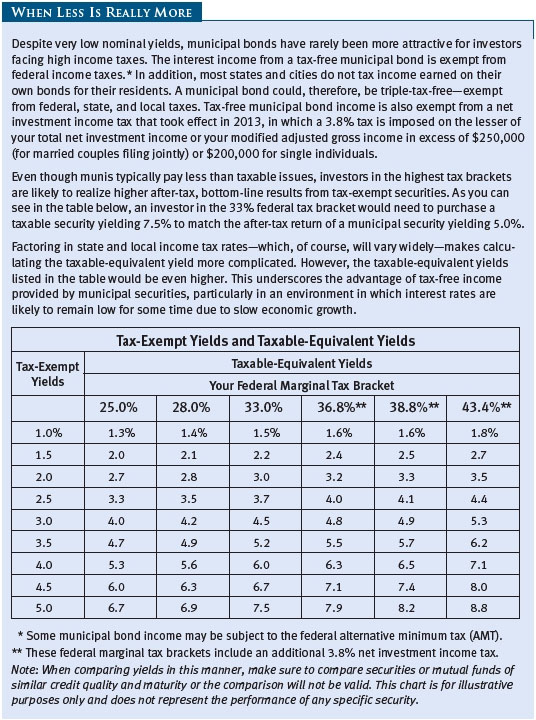
MUNICIPAL MARKET NEWS
New municipal issuance in the first eight months of 2014—approximately $203 billion, according to The Bond Buyer—was notably lower than issuance in the same period of 2013. In fact, new supply since mid-2013 has been somewhat limited, as last year’s increase in long-term interest rates made it less attractive for municipalities to borrow and refinance older debt. Outflows from the municipal market persisted throughout the second half of 2013, as rising rates and credit concerns in certain parts of the muni market restrained demand from individual investors during that period. These trends have reversed in 2014, as cash flows have returned to the market. High yield portfolios have received a significant portion of the flows.
Austerity-minded state and local government leaders remain conservative about adding to indebtedness, which we consider supportive. Indeed, most states have acted responsibly in the last few years by cutting spending and raising taxes and fees to close budget deficits. While state tax revenues are growing again, the cyclical pattern has been slower and more uneven than in the past, and expense pressures continue. We believe that many states deserve high credit ratings and that state governments will be able to continue servicing their outstanding debts. However, we continue to have longer-term concerns about the willingness and ability of some states to address sizable pension obligations and other retirement benefits.
The deteriorating fiscal situation in the Commonwealth of Puerto Rico hangs over the broader muni market, and we continue to have low exposure to this U.S. territory. Puerto Rico’s liabilities are large relative to the size of its economy, with close to $50 billion of municipal debt outstanding and over $70 billion of general indebtedness for the commonwealth and its various governmental agencies. Near the end of June, the commonwealth’s legislature approved a bill that would allow the territory’s public corporations, such as the Puerto Rico Electric Power Authority (PREPA), to restructure their debts; Puerto Rico’s general obligation (GO) bonds were not directly affected by the legislation. Since that time, PREPA reached an agreement with creditors to delay payments on nearly $700 million in bank loans until March 2015. However, PREPA’s long-term credit fundamentals remain poor and restructuring looms. Overall, we believe the market will absorb a PREPA restructuring without disruption.
In terms of sector performance, revenue bonds outperformed local and state GOs. We favor bonds backed by a dedicated revenue stream over GOs, with a bias toward transportation and utility bonds issued by these essential service providers. Among revenue bonds, the hospital, industrial/pollution control, and transportation segments were among the best-performing areas, as investors favored higher-yielding issues. While hospital revenue bonds are expensive relative to recent levels, we believe there is still some value in select names. There was little difference in the performance of most other revenue segments. Housing and special tax revenue bonds trailed but still produced good returns.
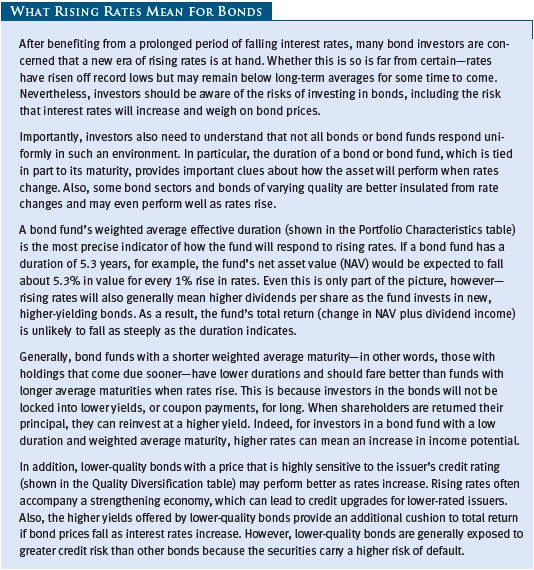
NEW YORK MARKET NEWS
Moody’s Investors Service rates New York State GO debt Aa1, while Standard & Poor’s and Fitch both rate the bonds AA+. All three rating agencies maintain a stable outlook on New York State after upgrading the state’s GO rating earlier this year. Credit agency ratings for New York City are Aa2 from Moody’s, AA from S&P, and AA from Fitch, all with stable outlooks.
New York’s employment growth slightly exceeded that of the U.S. as a whole in 2013, although the statewide unemployment rate, at 6.8% in July 2014, was higher than the national rate of 6.2%. Employment in New York City grew at a significantly higher rate in 2013 than in the U.S., but the city’s unemployment rate, at 8.0% in July 2014, continued to exceed state and national unemployment levels. The state’s 2012 per capita personal income was 114% of the national average, ranking it the fourth highest in the nation. We expect overall economic growth across the state to remain tepid.
The slowly recovering private sector has helped boost tax revenues and stabilize the state’s fiscal condition. Budgetary results for fiscal 2014 show a general fund balance of $2.2 billion, including $1.5 billion in “rainy day” reserves, which have been relatively stable for nearly a decade. Sizable financial settlements reached with several banks and insurance companies have led to a $4.2 billion upward revision in the general fund for balances in fiscal 2015. As a result, the state expects to close fiscal 2015 with a robust $6.2 billion general fund balance.
According to Moody’s 2014 State Debt Medians Report, New York is the second most heavily indebted state, with $63 billion of net tax-supported debt, and ranks fifth among all states for debt per capita and sixth for debt as a percentage of personal income. Unlike many other states, however, New York’s pension funds are relatively well funded, with an aggregate funded ratio of 89% as of April 1, 2013 (the latest available data). New York’s other post-employment benefit (OPEB) liability is high at $68 billion and primarily reflects health benefits for retired state and State University of New York employees. This liability was completely unfunded as of fiscal year 2014. The majority of New York’s debt is appropriation-backed, which means that the legislature must approve debt service payments on these obligations annually, and it has no legal requirement to continue consenting to these expenses.
New York City continues to demonstrate solid fiscal management, making multiyear financial plans and rolling forward budget surpluses from stronger years. Audited results for fiscal 2013 indicate that the city ended the year with a surplus of $6 billion (8.5% of revenues), which it rolled forward to help balance fiscal 2014 and fiscal 2015. Property taxes remain the city’s largest revenue source and act as a stabilizing factor given the city’s practice of phasing in tax assessments over five years. The city’s projected budget gaps between fiscal 2016 and fiscal 2018 have recently increased substantially due to the settlement of long outstanding labor contracts. While this is negative, those projections remain well below levels seen during the recession. Of more concern, New York City’s long-term liabilities are quite high. Per capita debt was close to $4,900 in fiscal 2013, and the city’s pension plans were only 61% funded at the end of the fiscal year, with the net OPEB obligation at a substantial $93 billion.
PORTFOLIO STRATEGIES
New York Tax-Free Money Fund
The New York Tax-Free Money Fund returned 0.01% for the six-month period ended August 31, 2014, as the Fed continued to keep its benchmark short-term interest rates in the historically low range of 0.00% to 0.25%. The seven-day simple yield also remained very low and ended August at 0.01%. While performance comparisons are difficult in this extremely low interest rate environment, the fund’s long-term record relative to its competitors remained favorable. (Based on cumulative total return, Lipper ranked the New York Tax-Free Money Fund 7 of 51, 24 of 50, 34 of 49, and 20 of 39 New York tax-exempt money market funds for the 1-, 3-, 5-, and 10-year periods ended August 31, 2014, respectively. Past performance cannot guarantee future results.)

Over the past six months, yields in the municipal money market continued to move lower. Rates range from five basis points (0.05%) for overnight maturities to 12 basis points (0.12%) for notes maturing in one year. The yield curve—which illustrates the relationship between yields and maturities of a similar security—flattened a few basis points as shorter-term rates were unchanged while rates on bonds with longer maturities, up to one year, declined four basis points (0.04%).
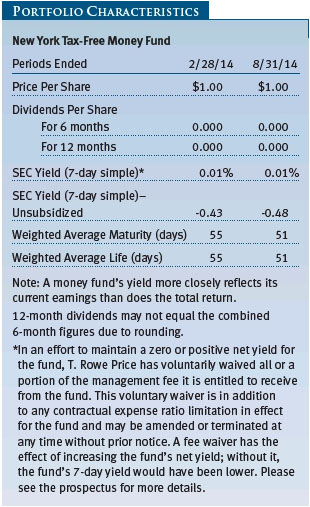
Lower rates continue to be driven by a supply/demand imbalance and dominated mostly by the overall low interest rate environment of the last six years. This situation has encouraged municipalities to prefer longer-maturity bonds to lock in favorable financing costs, thus reducing the available supply of shorter-maturity bonds. New issuance of variable rate demand notes (VRDNs)—debt instruments payable on demand that accrue interest based on a prevailing money market rate and which compose 62% of our holdings—has slowed significantly over the past few years because longer-term rates are more attractive. For example, prior to 2008, yearly VRDN issuance averaged $50 billion, but it had dropped to less than $8 billion in 2013. Pending bank regulations that could reduce the attractiveness of bank liquidity facilities used in short-term municipal financings could also complicate VRDN issuance. Despite these constraints on supply, investor demand remains fairly steady. We expect this changing investment landscape to pressure money market returns for some time to come.
Our commitment to maintaining a strict high-quality credit policy plays a central role in managing your fund. In that spirit, we favor highly rated credits such as housing finance, dedicated tax, and education revenue bonds. Some prominent positions in the portfolio include New York City Housing Authority, New York State Sales Tax Revenue, and Cornell University credits. We also continue to favor high-quality issuers that can provide self-liquidity. (Self-liquidity issuers do not need to rely upon third-party sources for liquidity.) Where self-liquidity is not possible, we look to intermediaries such as Federal National Mortgage Association, Toronto Dominion, and JP Morgan to supplement the liquidity of some municipal issuers. (Please refer to the fund’s portfolio of investments for a complete list of our holdings and the amount each represents in the portfolio.)

Given the imminent end of the Fed’s accommodative asset purchase program, some analysts suggest that the Fed may begin raising short-term interest rates within the next 12 months. However, yields in money markets are not expected to change significantly for quite some time. The tremendous demand for the short-dated, high-quality assets in which the fund invests suggests that higher rates will only manifest in the money markets a few months before the Fed tightens its policy. With that event still at the extreme end of our investment horizon, we remain comfortable operating in the longer end of our permissible weighted average maturity (WAM) range of 50 to 55 days. As always, we remain committed to managing a high-quality, diversified portfolio focused on liquidity and stability.
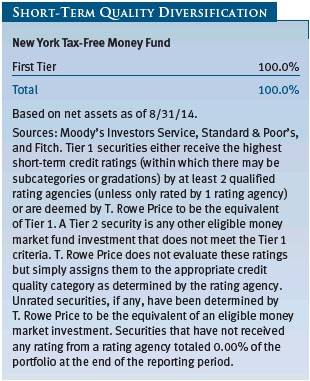
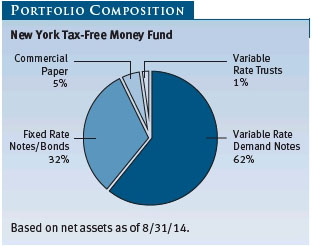
Finally, the U.S. Securities and Exchange Commission passed new rules in July that govern the management of all money market funds, including pricing, liquidity, risk management, and disclosure. While most individual investors will notice little change in their funds, institutional investors will be subject to more substantial changes over the next two years. T. Rowe Price is evaluating the potential impact of these changes, and we will keep shareholders informed about how they may be affected.
New York Tax-Free Bond Fund
Your fund returned 5.13% for the six-month period ended August 31, 2014, and outperformed its Lipper peer group average. The New York Tax-Free Bond Fund ranked in the top quintile of its Lipper peer group for the past 10 years and also compared favorably in other periods. (Based on cumulative total return, Lipper ranked the New York Tax-Free Bond Fund 29 of 102, 25 of 92, 26 of 82, and 14 of 71 New York municipal debt funds for the 1-, 3-, 5-, and 10-year periods ended August 31, 2014, respectively. Past performance cannot guarantee future results.)
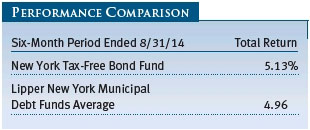
Over the past six months, the fund’s duration remained relatively unchanged at 4.7 years. We managed duration in a narrow range and kept it fairly close to that of the Barclays Municipal Bond Index. (Duration is a measure of the portfolio’s sensitivity to interest rate changes; the longer the duration, the greater the sensitivity.) We also held the fund’s WAM steady near 17 years, reflecting our view that the Fed will likely increase interest rates to more normal levels slowly.

The fund’s yield curve positioning remained largely unchanged. We have maintained an overweight to bonds with maturities of 15 years and longer compared with the Barclays Municipal Bond Index, as we believe longer-dated bonds offer greater value compared with other maturities. Bonds with shorter-term maturities offered generally meager yields, and their valuations appeared quite rich. Although we maintained a relatively high level of cash over most of the reporting period, weighing somewhat on performance, we eventually deployed these reserves and purchased several new issues.

Overall, the fund’s sector weightings changed little over our reporting period. The education revenue sector continues to represent the fund’s largest allocation, and we recently added Westchester County for Pace University and Hempstead NY for Adelphi University to our holdings. The transportation and health care sectors round out the fund’s three largest allocations. We continue to prefer revenue bonds over general obligation bonds, reflecting our longer-term concern that state and local governments will face fiscal challenges related to pension and health liabilities. (Please refer to the fund’s portfolio of investments for a complete list of our holdings and the amount each represents in the portfolio.)
The fund’s best performers were chiefly longer-duration, longer-maturity, and lower-rated securities. These holdings benefited as credit spreads narrowed and long-term interest rates declined and as investors continued to pursue higher yields. For example, yields on highly rated 30-year AAA rated municipal securities declined 69 basis points (0.69%) from 3.72% in February to 3.03% at the end of August. Meanwhile, rates on similarly rated five-year securities increased eight basis points (0.08%) over the same period. Conversely, returns on high-quality, shorter-maturity holdings lagged the broad market.
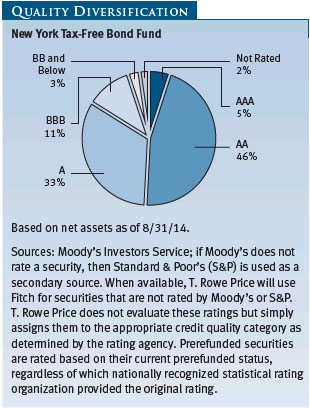
Similar to our last reporting period, we made minimal shifts in the portfolio’s quality diversification. Most notably, we increased the fund’s AA rated holdings by five percentage points as lower-quality bonds were difficult to find in the New York market and tighter credit spreads lessened their appeal. The fund is overweight to debt rated A and lower, though we have reduced our weighting from one year ago. During the reporting period, we eliminated our minimal position in Puerto Rico debt.
OUTLOOK
We believe that the municipal bond market remains a high-quality market that offers good opportunities for long-term investors seeking tax-free income—though we acknowledge that it has become more challenging to find attractive yields outside of Puerto Rico and other distressed segments of the market. We remain concerned about the potential for rising rates, but we believe that further rate increases will be at a more measured pace than what we witnessed last year—in part because the economic contraction in the first quarter of 2014 is tempering full-year growth expectations. We also believe that short- and intermediate-term rates could be more volatile than long-term rates as we approach the first Fed rate hike. When making investment decisions, we consider the forward-looking projections of rates and yield curves from our interest rate strategy and economics teams, and we will continue to be careful with any portfolio changes that might materially increase our portfolios’ interest rate sensitivity.
Fundamentally, the credit environment for municipalities is generally sound and should improve with the economy. Economic growth and higher income and sales tax revenues are providing some support for state and local governments, and a healthier real estate market should lead to higher property tax revenues for local governments. Taking a longer view, we remain concerned about state and local government liabilities such as pension benefits and retiree health care costs. While most municipal governments maintain balanced budgets, fewer municipalities have addressed these longer-term liabilities in a meaningful way. States will need to continue these efforts on their own, as a federal bailout of state and local governments without some losses to bondholders seems unlikely.
Detroit and Puerto Rico have generated negative headlines at times over the past year, and while they have taken steps to improve their finances that have generally been welcomed by the market, they could adversely affect the muni market in the period ahead. We continue to monitor Detroit’s bankruptcy proceedings closely because there is the potential for adverse legal precedents to arise out of the case. Detroit’s bankruptcy trial is scheduled to begin in September as the city seeks a judge’s approval of its restructuring plan. The outlook for Puerto Rico, which was downgraded to below investment grade in the first quarter, deteriorated dramatically at the end of June. Puerto Rico’s new law permitting public corporation debt restructurings led to sweeping credit rating downgrades in late June and early July, and it raises significant doubts about the commonwealth’s longstanding promises to meet its financial obligations. Our dedication to thorough, fundamental credit research has helped us minimize our exposure to this increasingly risky yet significant issuer of municipal bonds. However, given the magnitude of Puerto Rico’s debt and its broad ownership by institutional investors, additional negative credit events involving the commonwealth have the potential to trigger broad selling and disruptions in the municipal market. While we are not predicting such an outcome, we would use it as an opportunity to find and buy good municipal credits.
Ultimately, we believe that T. Rowe Price’s independent credit research is our greatest strength and will remain an asset for our investors as we navigate the current market environment. As always, we are on the lookout for attractively valued bonds issued by municipalities with good long-term fundamentals—an investment strategy that we believe will continue to serve our investors well.
Thank you for investing with T. Rowe Price.
Respectfully submitted,

Joseph K. Lynagh
Chairman of the Investment Advisory Committee
New York Tax-Free Money Fund

Konstantine B. Mallas
Chairman of the Investment Advisory Committee
New York Tax-Free Bond Fund
September 12, 2014
The committee chairmen have day-to-day responsibility for managing the portfolios and work with committee members in developing and executing the funds’ investment programs.
RISKS OF FIXED INCOME INVESTING
Since money market funds are managed to maintain a constant $1.00 share price, there should be little risk of principal loss. However, there is no assurance the fund will avoid principal losses if fund holdings default or are downgraded or if interest rates rise sharply in an unusually short period. In addition, the fund’s yield will vary; it is not fixed for a specific period like the yield on a bank certificate of deposit. An investment in the fund is not insured or guaranteed by the Federal Deposit Insurance Corporation (FDIC) or any other government agency. Although a money market fund seeks to preserve the value of your investment at $1.00 per share, it is possible to lose money by investing in it. Bonds are subject to interest rate risk (the decline in bond prices that usually accompanies a rise in interest rates) and credit risk (the chance that any fund holding could have its credit rating downgraded or that a bond issuer will default by failing to make timely payments of interest or principal), potentially reducing the fund’s income level and share price.
GLOSSARY
Barclays Municipal Bond Index: A broadly diversified index of tax-exempt bonds.
Basis point: One one-hundredth of one percentage point, or 0.01%.
Credit spreads: The amount of additional yield demanded by bond investors in exchange for buying riskier assets.
Duration: A measure of a bond fund’s sensitivity to changes in interest rates. For example, a fund with a duration of five years would fall about 5% in price in response to a one-percentage-point rise in interest rates, and vice versa.
General obligation (GO) debt: A government’s strongest pledge that obligates its full faith and credit, including, if necessary, its ability to raise taxes.
Gross domestic product: The total market value of all goods and services produced in a country in a given year.
Investment grade: High-quality bonds as measured by one of the major credit rating agencies. For example, Standard & Poor’s designates the bonds in its top four categories (AAA to BBB) as investment grade.
Lipper averages: The averages of available mutual fund performance returns for specified time periods in categories defined by Lipper Inc.
Lipper indexes: Fund benchmarks that consist of a small number (10 to 30) of the largest mutual funds in a particular category as tracked by Lipper Inc.
Other post-employment benefits (OPEB): Benefits paid to an employee after retirement such as premiums for life and health insurance.
Prerefunded bond: A bond that originally may have been issued as a general obligation or revenue bond but that is now secured by an escrow fund consisting entirely of direct U.S. government obligations that are sufficient for paying the bondholders.
Revenue (or revenue-backed) bond: A bond issued to fund specific projects, such as airports, bridges, hospitals, and toll roads, where a portion of the revenue generated is used to service the interest payments on the bond.
SEC yield (7-day simple): A method of calculating a money fund’s yield by annualizing the fund’s net investment income for the last seven days of each period divided by the fund’s net asset value at the end of the period. Yield will vary and is not guaranteed.
SEC yield (30-day): A method of calculating a fund’s yield that assumes all securities are held until maturity. Yield will vary and is not guaranteed.
Self-liquidity: Issuers who do not need to rely upon third-party sources of liquidity, such as that provided by banks in the forms of letters of credit or standby purchase agreements.
Variable rate demand note (VRDN): Generally, a debt security that requires the issuer to redeem at the holder’s discretion on a specified date or dates prior to maturity. Upon redemption, the issuer pays par to the holder who loses future coupon payments that might otherwise be due. The VRDN might be especially attractive at times of rising rates to protect against interest rate risk by redeeming at par value and reinvesting proceeds in a new bond.
Weighted average life: A measure of a fund’s credit quality risk. In general, the longer the average life, the greater the fund’s credit quality risk. The average life is the dollar-weighted average maturity of a portfolio’s individual securities without taking into account interest rate readjustment dates. Money funds must maintain a weighted average life of less than 120 days.
Weighted average maturity (WAM): A measure of a fund’s interest rate sensitivity. In general, the longer the average maturity, the greater the fund’s sensitivity to interest rate changes. The weighted average maturity may take into account the interest rate readjustment dates for certain securities. Money funds must maintain a weighted average maturity of less than 60 days.
Yield curve: A graph depicting the relationship between yields and maturity dates for a set of similar securities. These curves are in constant flux. One of the key activities in managing any fixed income portfolio is to study the trends reflected by yield curves.
Performance and Expenses
| Growth of $10,000 |
This chart shows the value of a hypothetical $10,000 investment in the fund over the past 10 fiscal year periods or since inception (for funds lacking 10-year records). The result is compared with benchmarks, which may include a broad-based market index and a peer group average or index. Market indexes do not include expenses, which are deducted from fund returns as well as mutual fund averages and indexes.


| Growth of $10,000 |
This chart shows the value of a hypothetical $10,000 investment in the fund over the past 10 fiscal year periods or since inception (for funds lacking 10-year records). The result is compared with benchmarks, which may include a broad-based market index and a peer group average or index. Market indexes do not include expenses, which are deducted from fund returns as well as mutual fund averages and indexes.
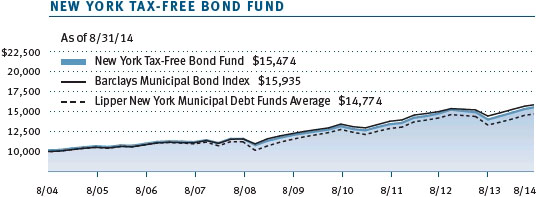

| Fund Expense Example |
As a mutual fund shareholder, you may incur two types of costs: (1) transaction costs, such as redemption fees or sales loads, and (2) ongoing costs, including management fees, distribution and service (12b-1) fees, and other fund expenses. The following example is intended to help you understand your ongoing costs (in dollars) of investing in the fund and to compare these costs with the ongoing costs of investing in other mutual funds. The example is based on an investment of $1,000 invested at the beginning of the most recent six-month period and held for the entire period.
Actual Expenses
The first line of the following table (Actual) provides information about actual account values and expenses based on the fund’s actual returns. You may use the information on this line, together with your account balance, to estimate the expenses that you paid over the period. Simply divide your account value by $1,000 (for example, an $8,600 account value divided by $1,000 = 8.6), then multiply the result by the number on the first line under the heading “Expenses Paid During Period” to estimate the expenses you paid on your account during this period.
Hypothetical Example for Comparison Purposes
The information on the second line of the table (Hypothetical) is based on hypothetical account values and expenses derived from the fund’s actual expense ratio and an assumed 5% per year rate of return before expenses (not the fund’s actual return). You may compare the ongoing costs of investing in the fund with other funds by contrasting this 5% hypothetical example and the 5% hypothetical examples that appear in the shareholder reports of the other funds. The hypothetical account values and expenses may not be used to estimate the actual ending account balance or expenses you paid for the period.
Note: T. Rowe Price charges an annual account service fee of $20, generally for accounts with less than $10,000. The fee is waived for any investor whose T. Rowe Price mutual fund accounts total $50,000 or more; accounts electing to receive electronic delivery of account statements, transaction confirmations, prospectuses, and shareholder reports; or accounts of an investor who is a T. Rowe Price Preferred Services, Personal Services, or Enhanced Personal Services client (enrollment in these programs generally requires T. Rowe Price assets of at least $100,000). This fee is not included in the accompanying table. If you are subject to the fee, keep it in mind when you are estimating the ongoing expenses of investing in the fund and when comparing the expenses of this fund with other funds.
You should also be aware that the expenses shown in the table highlight only your ongoing costs and do not reflect any transaction costs, such as redemption fees or sales loads. Therefore, the second line of the table is useful in comparing ongoing costs only and will not help you determine the relative total costs of owning different funds. To the extent a fund charges transaction costs, however, the total cost of owning that fund is higher.

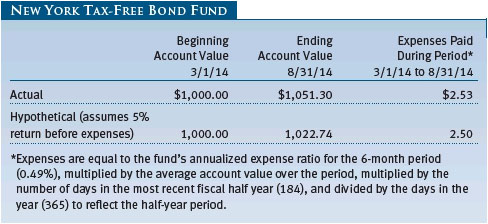


Unaudited
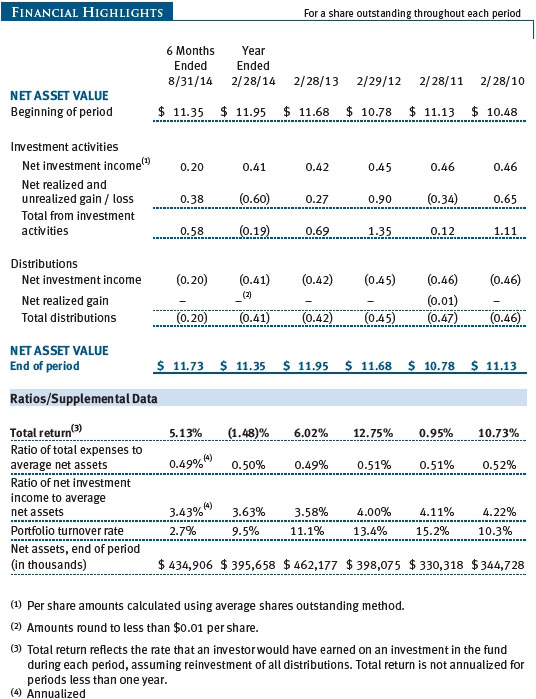
The accompanying notes are an integral part of these financial statements.
Unaudited
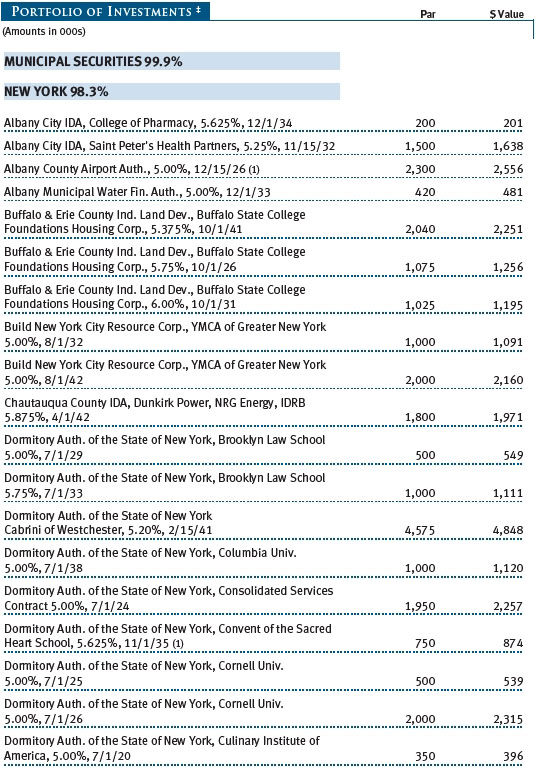


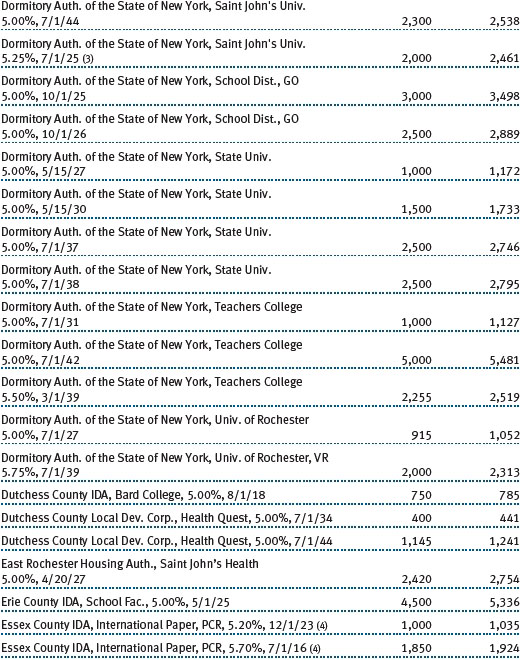
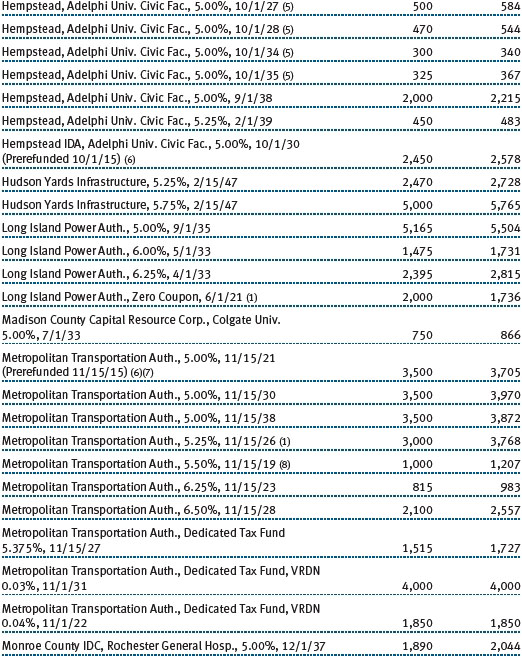

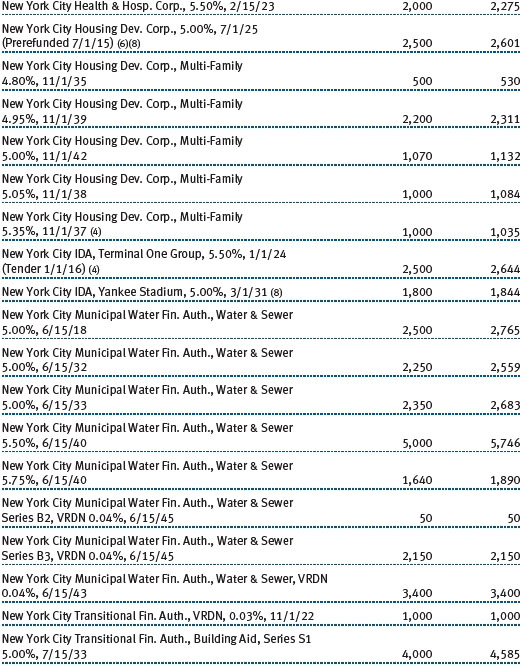






The accompanying notes are an integral part of these financial statements.
Unaudited
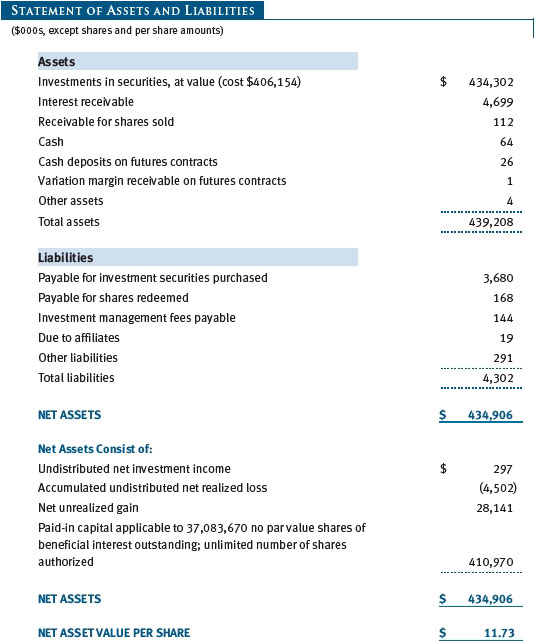
The accompanying notes are an integral part of these financial statements.
Unaudited
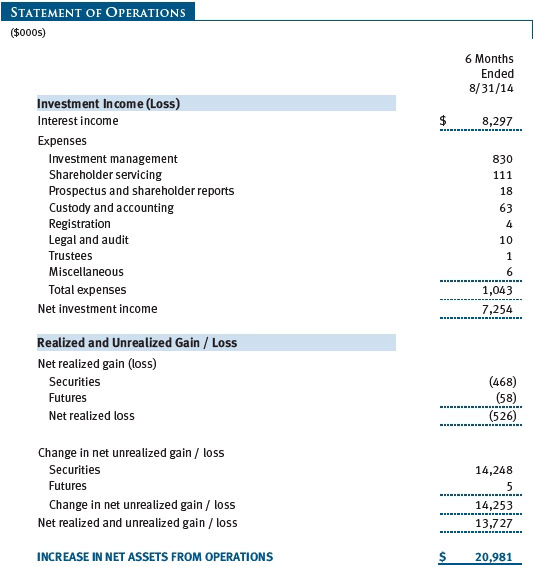
The accompanying notes are an integral part of these financial statements.
Unaudited

The accompanying notes are an integral part of these financial statements.
Unaudited
| Notes to Financial Statements |
T. Rowe Price State Tax-Free Income Trust (the trust), is registered under the Investment Company Act of 1940 (the 1940 Act). The New York Tax-Free Bond Fund (the fund) is a nondiversified, open-end management investment company established by the trust. The fund commenced operations on August 28, 1986. The fund seeks to provide, consistent with prudent portfolio management, the highest level of income exempt from federal, New York state, and New York City income taxes by investing primarily in investment-grade New York municipal bonds.
NOTE 1 - SIGNIFICANT ACCOUNTING POLICIES
Basis of Preparation The fund is an investment company and follows accounting and reporting guidance in the Financial Accounting Standards Board (FASB) Accounting Standards Codification Topic 946 (ASC 946). The accompanying financial statements were prepared in accordance with accounting principles generally accepted in the United States of America (GAAP), including but not limited to ASC 946. GAAP requires the use of estimates made by management. Management believes that estimates and valuations are appropriate; however, actual results may differ from those estimates, and the valuations reflected in the accompanying financial statements may differ from the value ultimately realized upon sale or maturity.
Investment Transactions, Investment Income, and Distributions Income and expenses are recorded on the accrual basis. Premiums and discounts on debt securities are amortized for financial reporting purposes. Income tax-related interest and penalties, if incurred, would be recorded as income tax expense. Investment transactions are accounted for on the trade date. Realized gains and losses are reported on the identified cost basis. Distributions to shareholders are recorded on the ex-dividend date. Income distributions are declared daily and paid monthly. Capital gain distributions, if any, are generally declared and paid by the fund annually.
New Accounting Guidance In June 2014, FASB issued Accounting Standards Update (ASU) No. 2014-11, Transfers and Servicing (Topic 860), Repurchase-to-Maturity Transactions, Repurchase Financings, and Disclosures. The ASU changes the accounting for certain repurchase agreements and expands disclosure requirements related to repurchase agreements, securities lending, repurchase-to-maturity and similar transactions. The ASU is effective for interim and annual reporting periods beginning after December 15, 2014. Adoption will have no effect on the fund’s net assets or results of operations.
NOTE 2 - VALUATION
The fund’s financial instruments are valued and its net asset value (NAV) per share is computed at the close of the New York Stock Exchange (NYSE), normally 4 p.m. ET, each day the NYSE is open for business.
Fair Value The fund’s financial instruments are reported at fair value, which GAAP defines as the price that would be received to sell an asset or paid to transfer a liability in an orderly transaction between market participants at the measurement date. The T. Rowe Price Valuation Committee (the Valuation Committee) has been established by the fund’s Board of Trustees (the Board) to ensure that financial instruments are appropriately priced at fair value in accordance with GAAP and the 1940 Act. Subject to oversight by the Board, the Valuation Committee develops and oversees pricing-related policies and procedures and approves all fair value determinations. Specifically, the Valuation Committee establishes procedures to value securities; determines pricing techniques, sources, and persons eligible to effect fair value pricing actions; oversees the selection, services, and performance of pricing vendors; oversees valuation-related business continuity practices; and provides guidance on internal controls and valuation-related matters. The Valuation Committee reports to the fund’s Board; is chaired by the fund’s treasurer; and has representation from legal, portfolio management and trading, operations, and risk management.
Various valuation techniques and inputs are used to determine the fair value of financial instruments. GAAP establishes the following fair value hierarchy that categorizes the inputs used to measure fair value:
Level 1 – quoted prices (unadjusted) in active markets for identical financial instruments that the fund can access at the reporting date
Level 2 – inputs other than Level 1 quoted prices that are observable, either directly or indirectly (including, but not limited to, quoted prices for similar financial instruments in active markets, quoted prices for identical or similar financial instruments in inactive markets, interest rates and yield curves, implied volatilities, and credit spreads)
Level 3 – unobservable inputs
Observable inputs are developed using market data, such as publicly available information about actual events or transactions, and reflect the assumptions that market participants would use to price the financial instrument. Unobservable inputs are those for which market data are not available and are developed using the best information available about the assumptions that market participants would use to price the financial instrument. GAAP requires valuation techniques to maximize the use of relevant observable inputs and minimize the use of unobservable inputs. When multiple inputs are used to derive fair value, the financial instrument is assigned to the level within the fair value hierarchy based on the lowest-level input that is significant to the fair value of the financial instrument. Input levels are not necessarily an indication of the risk or liquidity associated with financial instruments at that level but rather the degree of judgment used in determining those values.
Valuation Techniques Debt securities generally are traded in the over-the-counter (OTC) market. Securities with remaining maturities of one year or more at the time of acquisition are valued at prices furnished by dealers who make markets in such securities or by an independent pricing service, which considers the yield or price of bonds of comparable quality, coupon, maturity, and type, as well as prices quoted by dealers who make markets in such securities. Securities with remaining maturities of less than one year at the time of acquisition generally use amortized cost in local currency to approximate fair value. However, if amortized cost is deemed not to reflect fair value or the fund holds a significant amount of such securities with remaining maturities of more than 60 days, the securities are valued at prices furnished by dealers who make markets in such securities or by an independent pricing service. Generally, debt securities are categorized in Level 2 of the fair value hierarchy; however, to the extent the valuations include significant unobservable inputs, the securities would be categorized in Level 3.
Financial futures contracts are valued at closing settlement prices and are categorized in Level 1 of the fair value hierarchy. Assets and liabilities other than financial instruments, including short-term receivables and payables, are carried at cost, or estimated realizable value, if less, which approximates fair value.
Thinly traded financial instruments and those for which the above valuation procedures are inappropriate or are deemed not to reflect fair value are stated at fair value as determined in good faith by the Valuation Committee. The objective of any fair value pricing determination is to arrive at a price that could reasonably be expected from a current sale. Financial instruments fair valued by the Valuation Committee are primarily private placements, restricted securities, warrants, rights, and other securities that are not publicly traded.
Subject to oversight by the Board, the Valuation Committee regularly makes good faith judgments to establish and adjust the fair valuations of certain securities as events occur and circumstances warrant. For instance, in determining the fair value of troubled or thinly traded debt instruments, the Valuation Committee considers a variety of factors, which may include, but are not limited to, the issuer’s business prospects, its financial standing and performance, recent investment transactions in the issuer, strategic events affecting the company, market liquidity for the issuer, and general economic conditions and events. In consultation with the investment and pricing teams, the Valuation Committee will determine an appropriate valuation technique based on available information, which may include both observable and unobservable inputs. The Valuation Committee typically will afford greatest weight to actual prices in arm’s length transactions, to the extent they represent orderly transactions between market participants; transaction information can be reliably obtained; and prices are deemed representative of fair value. However, the Valuation Committee may also consider other valuation methods such as a discount or premium from market value of a similar, freely traded security of the same issuer; discounted cash flows; yield to maturity; or some combination. Fair value determinations are reviewed on a regular basis and updated as information becomes available, including actual purchase and sale transactions of the issue. Because any fair value determination involves a significant amount of judgment, there is a degree of subjectivity inherent in such pricing decisions, and fair value prices determined by the Valuation Committee could differ from those of other market participants. Depending on the relative significance of unobservable inputs, including the valuation technique(s) used, fair valued securities may be categorized in Level 2 or 3 of the fair value hierarchy.
Valuation Inputs The following table summarizes the fund’s financial instruments, based on the inputs used to determine their fair values on August 31, 2014:
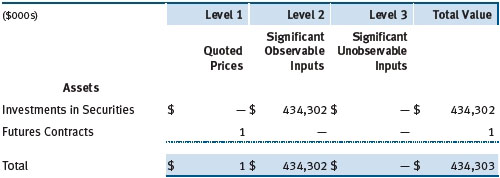
There were no material transfers between Levels 1 and 2 during the six months ended August 31, 2014.
NOTE 3 - DERIVATIVE INSTRUMENTS
During the six months ended August 31, 2014, the fund invested in derivative instruments. As defined by GAAP, a derivative is a financial instrument whose value is derived from an underlying security price, foreign exchange rate, interest rate, index of prices or rates, or other variable; it requires little or no initial investment and permits or requires net settlement. The fund invests in derivatives only if the expected risks and rewards are consistent with its investment objectives, policies, and overall risk profile, as described in its prospectus and Statement of Additional Information. The fund may use derivatives for a variety of purposes, such as seeking to hedge against declines in principal value, increase yield, invest in an asset with greater efficiency and at a lower cost than is possible through direct investment, or to adjust portfolio duration and credit exposure. The risks associated with the use of derivatives are different from, and potentially much greater than, the risks associated with investing directly in the instruments on which the derivatives are based. The fund at all times maintains sufficient cash reserves, liquid assets, or other SEC-permitted asset types to cover its settlement obligations under open derivative contracts.
The fund values its derivatives at fair value, as described in Note 2, and recognizes changes in fair value currently in its results of operations. Accordingly, the fund does not follow hedge accounting, even for derivatives employed as economic hedges. Generally, the fund accounts for its derivatives on a gross basis. It does not offset the fair value of derivative liabilities against the fair value of derivative assets on its financial statements, nor does it offset the fair value of derivative instruments against the right to reclaim or obligation to return collateral. As of August 31, 2014, the fund held interest rate futures with cumulative unrealized loss of $7,000; the value reflected on the accompanying Statement of Assets and Liabilities is the related unsettled variation margin.
Additionally, during the six months ended August 31, 2014, the fund recognized $58,000 of realized loss on Futures and a $5,000 change in unrealized gain/loss on Futures related to its investments in interest rate derivatives; such amounts are included on the accompanying Statement of Operations.
Counterparty Risk and Collateral The fund invests in exchange-traded or centrally cleared derivative contracts, such as futures, exchange-traded options, and centrally cleared swaps. Counterparty risk on such derivatives is minimal because the clearinghouse provides protection against counterparty defaults. For futures and centrally cleared swaps, the fund is required to deposit collateral in an amount equal to a certain percentage of the contract value (margin requirement), and the margin requirement must be maintained over the life of the contract. Each clearing broker, in its sole discretion, may adjust the margin requirements applicable to the fund.
Collateral may be in the form of cash or debt securities issued by the U.S. government or related agencies. Cash and currencies posted by the fund are reflected as cash deposits in the accompanying financial statements and generally are restricted from withdrawal by the fund; securities posted by the fund are so noted in the accompanying Portfolio of Investments; both remain in the fund’s assets. As of August 31, 2014, cash of $26,000 had been posted by the fund for exchange-traded and/or centrally cleared derivatives.
Futures Contracts The fund is subject to interest rate risk in the normal course of pursuing its investment objectives and uses futures contracts to help manage such risk. The fund may enter into futures contracts to manage exposure to interest rate and yield curve movements, security prices, foreign currencies, credit quality, and mortgage prepayments; as an efficient means of adjusting exposure to all or part of a target market; to enhance income; as a cash management tool; or to adjust portfolio duration and credit exposure. A futures contract provides for the future sale by one party and purchase by another of a specified amount of a particular underlying financial instrument at an agreed-upon price, date, time, and place. The fund currently invests only in exchange-traded futures, which generally are standardized as to maturity date, underlying financial instrument, and other contract terms. Payments are made or received by the fund each day to settle daily fluctuations in the value of the contract (variation margin), which reflect changes in the value of the underlying financial instrument. Variation margin is recorded as unrealized gain or loss until the contract is closed. The value of a futures contract included in net assets is the amount of unsettled variation margin; net variation margin receivable is reflected as an asset and net variation margin payable is reflected as a liability on the accompanying Statement of Assets and Liabilities. Risks related to the use of futures contracts include possible illiquidity of the futures markets, contract prices that can be highly volatile and imperfectly correlated to movements in hedged security values and/or interest rates, and potential losses in excess of the fund’s initial investment. During the six months ended August 31, 2014, the volume of the fund’s activity in futures, based on underlying notional amounts, was generally less than 1% of net assets.
NOTE 4 - OTHER INVESTMENT TRANSACTIONS
Consistent with its investment objective, the fund engages in the following practices to manage exposure to certain risks and/or to enhance performance. The investment objective, policies, program, and risk factors of the fund are described more fully in the fund’s prospectus and Statement of Additional Information.
Restricted Securities The fund may invest in securities that are subject to legal or contractual restrictions on resale. Prompt sale of such securities at an acceptable price may be difficult and may involve substantial delays and additional costs.
When-Issued Securities The fund may enter into when-issued purchase or sale commitments, pursuant to which it agrees to purchase or sell, respectively, an authorized but not yet issued security for a fixed unit price, with payment and delivery not due until issuance of the security on a scheduled future date. When-issued securities may be new securities or securities issued through a corporate action, such as a reorganization or restructuring. Until settlement, the fund maintains liquid assets sufficient to settle its commitment to purchase a when-issued security or, in the case of a sale commitment, the fund maintains an entitlement to the security to be sold. Amounts realized on when-issued transactions are included in realized gain/loss on securities in the accompanying financial statements.
Other Purchases and sales of portfolio securities other than short-term securities aggregated $32,676,000 and $10,988,000, respectively, for the six months ended August 31, 2014.
NOTE 5 - FEDERAL INCOME TAXES
No provision for federal income taxes is required since the fund intends to continue to qualify as a regulated investment company under Subchapter M of the Internal Revenue Code and distribute to shareholders all of its income and gains. Distributions determined in accordance with federal income tax regulations may differ in amount or character from net investment income and realized gains for financial reporting purposes. Financial reporting records are adjusted for permanent book/tax differences to reflect tax character but are not adjusted for temporary differences. The amount and character of tax-basis distributions and composition of net assets are finalized at fiscal year-end; accordingly, tax-basis balances have not been determined as of the date of this report.
The fund intends to retain realized gains to the extent of available capital loss carryforwards. Because the fund is required to use capital loss carryforwards that do not expire before those with expiration dates, all or a portion of its capital loss carryforwards subject to expiration could ultimately go unused. As of February 28, 2014, the fund had $3,898,000 of available capital loss carryforwards, which expire as follows: $996,000 in fiscal 2017 and $448,000 in fiscal 2018; $2,454,000 have no expiration.
At August 31, 2014, the cost of investments for federal income tax purposes was $405,968,000. Net unrealized gain aggregated $28,327,000 at period-end, of which $28,979,000 related to appreciated investments and $652,000 related to depreciated investments.
NOTE 6 - RELATED PARTY TRANSACTIONS
The fund is managed by T. Rowe Price Associates, Inc. (Price Associates), a wholly owned subsidiary of T. Rowe Price Group, Inc. (Price Group). The investment management agreement between the fund and Price Associates provides for an annual investment management fee, which is computed daily and paid monthly. The fee consists of an individual fund fee, equal to 0.10% of the fund’s average daily net assets, and a group fee. The group fee rate is calculated based on the combined net assets of certain mutual funds sponsored by Price Associates (the group) applied to a graduated fee schedule, with rates ranging from 0.48% for the first $1 billion of assets to 0.275% for assets in excess of $400 billion. The fund’s group fee is determined by applying the group fee rate to the fund’s average daily net assets. At August 31, 2014, the effective annual group fee rate was 0.29%.
In addition, the fund has entered into service agreements with Price Associates and a wholly owned subsidiary of Price Associates (collectively, Price). Price Associates computes the daily share price and provides certain other administrative services to the fund. T. Rowe Price Services, Inc., provides shareholder and administrative services in its capacity as the fund’s transfer and dividend-disbursing agent. For the six months ended August 31, 2014, expenses incurred pursuant to these service agreements were $47,000 for Price Associates and $56,000 for T. Rowe Price Services, Inc. The total amount payable at period-end pursuant to these service agreements is reflected as Due to Affiliates in the accompanying financial statements.
| Information on Proxy Voting Policies, Procedures, and Records |
A description of the policies and procedures used by T. Rowe Price funds and portfolios to determine how to vote proxies relating to portfolio securities is available in each fund’s Statement of Additional Information. You may request this document by calling 1-800-225-5132 or by accessing the SEC’s website, sec.gov.
The description of our proxy voting policies and procedures is also available on our website, troweprice.com. To access it, click on the words “Social Responsibility” at the top of our corporate homepage. Next, click on the words “Conducting Business Responsibly” on the left side of the page that appears. Finally, click on the words “Proxy Voting Policies” on the left side of the page that appears.
Each fund’s most recent annual proxy voting record is available on our website and through the SEC’s website. To access it through our website, follow the above directions to reach the “Conducting Business Responsibly” page. Click on the words “Proxy Voting Records” on the left side of that page, and then click on the “View Proxy Voting Records” link at the bottom of the page that appears.
| How to Obtain Quarterly Portfolio Holdings |
The fund files a complete schedule of portfolio holdings with the Securities and Exchange Commission for the first and third quarters of each fiscal year on Form N-Q. The fund’s Form N-Q is available electronically on the SEC’s website (sec.gov); hard copies may be reviewed and copied at the SEC’s Public Reference Room, 100 F St. N.E., Washington, DC 20549. For more information on the Public Reference Room, call 1-800-SEC-0330.
| Approval of Investment Management Agreement |
On April 30, 2014, the fund’s Board of Trustees (Board), including a majority of the fund’s independent trustees, approved the continuation of the investment management agreement (Advisory Contract) between the fund and its investment advisor, T. Rowe Price Associates, Inc. (Advisor). The April meeting followed a telephonic meeting held on March 4, 2014, during which the Board reviewed information and discussed the continuation of the Advisory Contract. In connection with its deliberations, the Board requested, and the Advisor provided, such information as the Board (with advice from independent legal counsel) deemed reasonably necessary. The Board considered a variety of factors in connection with its review of the Advisory Contract, also taking into account information provided by the Advisor during the course of the year, as discussed below:
Services Provided by the Advisor
The Board considered the nature, quality, and extent of the services provided to the fund by the Advisor. These services included, but were not limited to, directing the fund’s investments in accordance with its investment program and the overall management of the fund’s portfolio, as well as a variety of related activities such as financial, investment operations, and administrative services; compliance; maintaining the fund’s records and registrations; and shareholder communications. The Board also reviewed the background and experience of the Advisor’s senior management team and investment personnel involved in the management of the fund, as well as the Advisor’s compliance record. The Board concluded that it was satisfied with the nature, quality, and extent of the services provided by the Advisor.
Investment Performance of the Fund
The Board reviewed the fund’s three-month, one-year, and year-by-year returns, as well as the fund’s average annualized total returns over the 3-, 5-, and 10-year periods, and compared these returns with a wide variety of previously agreed upon comparable performance measures and market data, including those supplied by Lipper and Morningstar, which are independent providers of mutual fund data.
On the basis of this evaluation and the Board’s ongoing review of investment results, and factoring in the relative market conditions during certain of the performance periods, the Board concluded that the fund’s performance was satisfactory.
Costs, Benefits, Profits, and Economies of Scale
The Board reviewed detailed information regarding the revenues received by the Advisor under the Advisory Contract and other benefits that the Advisor (and its affiliates) may have realized from its relationship with the fund, including any research received under “soft dollar” agreements and commission-sharing arrangements with broker-dealers. The Board considered that the Advisor may receive some benefit from soft-dollar arrangements pursuant to which research is received from broker-dealers that execute the applicable fund’s portfolio transactions. The Board received information on the estimated costs incurred and profits realized by the Advisor from managing T. Rowe Price mutual funds. The Board also reviewed estimates of the profits realized from managing the fund in particular and the Board concluded that the Advisor’s profits were reasonable in light of the services provided to the fund.
The Board also considered whether the fund benefits under the fee levels set forth in the Advisory Contract from any economies of scale realized by the Advisor. Under the Advisory Contract, the fund pays a fee to the Advisor for investment management services composed of two components—a group fee rate based on the combined average net assets of most of the T. Rowe Price mutual funds (including the fund) that declines at certain asset levels and an individual fund fee rate based on the fund’s average daily net assets—and the fund pays its own expenses of operations. The Board concluded that the advisory fee structure for the fund continued to provide for a reasonable sharing of benefits from any economies of scale with the fund’s investors.
Fees
The Board was provided with information regarding industry trends in management fees and expenses, and the Board reviewed the fund’s management fee rate, operating expenses, and total expense ratio in comparison with fees and expenses of other comparable funds based on information and data supplied by Lipper. The information provided to the Board indicated that the fund’s management fee rate and total expense ratio were above the median for certain groups of comparable funds and at or below the median for other groups of comparable funds.
The Board also reviewed the fee schedules for institutional accounts and private accounts with similar mandates that are advised or subadvised by the Advisor and its affiliates. Management provided the Board with information about the Advisor’s responsibilities and services provided to institutional account clients, including information about how the requirements and economics of the institutional business are fundamentally different from those of the mutual fund business. The Board considered information showing that the mutual fund business is generally more complex from a business and compliance perspective than the institutional business and that the Advisor generally performs significant additional services and assumes greater risk in managing the fund and other T. Rowe Price mutual funds than it does for institutional account clients.
On the basis of the information provided and the factors considered, the Board concluded that the fees paid by the fund under the Advisory Contract are reasonable.
Approval of the Advisory Contract
As noted, the Board approved the continuation of the Advisory Contract. No single factor was considered in isolation or to be determinative to the decision. Rather, the Board concluded, in light of a weighting and balancing of all factors considered, that it was in the best interests of the fund and its shareholders for the Board to approve the continuation of the Advisory Contract (including the fees to be charged for services thereunder). The independent directors were advised throughout the process by independent legal counsel.
Item 2. Code of Ethics.
A code of ethics, as defined in Item 2 of Form N-CSR, applicable to its principal executive officer, principal financial officer, principal accounting officer or controller, or persons performing similar functions is filed as an exhibit to the registrant’s annual Form N-CSR. No substantive amendments were approved or waivers were granted to this code of ethics during the registrant’s most recent fiscal half-year.
Item 3. Audit Committee Financial Expert.
Disclosure required in registrant’s annual Form N-CSR.
Item 4. Principal Accountant Fees and Services.
Disclosure required in registrant’s annual Form N-CSR.
Item 5. Audit Committee of Listed Registrants.
Not applicable.
Item 6. Investments.
(a) Not applicable. The complete schedule of investments is included in Item 1 of this Form N-CSR.
(b) Not applicable.
Item 7. Disclosure of Proxy Voting Policies and Procedures for Closed-End Management Investment Companies.
Not applicable.
Item 8. Portfolio Managers of Closed-End Management Investment Companies.
Not applicable.
Item 9. Purchases of Equity Securities by Closed-End Management Investment Company and Affiliated Purchasers.
Not applicable.
Item 10. Submission of Matters to a Vote of Security Holders.
Not applicable.
Item 11. Controls and Procedures.
(a) The registrant’s principal executive officer and principal financial officer have evaluated the registrant’s disclosure controls and procedures within 90 days of this filing and have concluded that the registrant’s disclosure controls and procedures were effective, as of that date, in ensuring that information required to be disclosed by the registrant in this Form N-CSR was recorded, processed, summarized, and reported timely.
(b) The registrant’s principal executive officer and principal financial officer are aware of no change in the registrant’s internal control over financial reporting that occurred during the registrant’s second fiscal quarter covered by this report that has materially affected, or is reasonably likely to materially affect, the registrant’s internal control over financial reporting.
Item 12. Exhibits.
(a)(1) The registrant’s code of ethics pursuant to Item 2 of Form N-CSR is filed with the registrant’s annual Form N-CSR.
(2) Separate certifications by the registrant's principal executive officer and principal financial officer, pursuant to Section 302 of the Sarbanes-Oxley Act of 2002 and required by Rule 30a-2(a) under the Investment Company Act of 1940, are attached.
(3) Written solicitation to repurchase securities issued by closed-end companies: not applicable.
(b) A certification by the registrant's principal executive officer and principal financial officer, pursuant to Section 906 of the Sarbanes-Oxley Act of 2002 and required by Rule 30a-2(b) under the Investment Company Act of 1940, is attached.
SIGNATURES
Pursuant to the requirements of the Securities Exchange Act of 1934 and the Investment Company Act of 1940, the registrant has duly caused this report to be signed on its behalf by the undersigned, thereunto duly authorized.
T. Rowe Price State Tax-Free Income Trust
| By | /s/ Edward C. Bernard | |
| Edward C. Bernard | ||
| Principal Executive Officer | ||
| Date October 16, 2014 | ||
Pursuant to the requirements of the Securities Exchange Act of 1934 and the Investment Company Act of 1940, this report has been signed below by the following persons on behalf of the registrant and in the capacities and on the dates indicated.
| By | /s/ Edward C. Bernard | |
| Edward C. Bernard | ||
| Principal Executive Officer | ||
| Date October 16, 2014 | ||
| By | /s/ Gregory K. Hinkle | |
| Gregory K. Hinkle | ||
| Principal Financial Officer | ||
| Date October 16, 2014 | ||